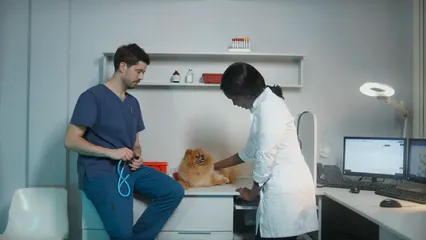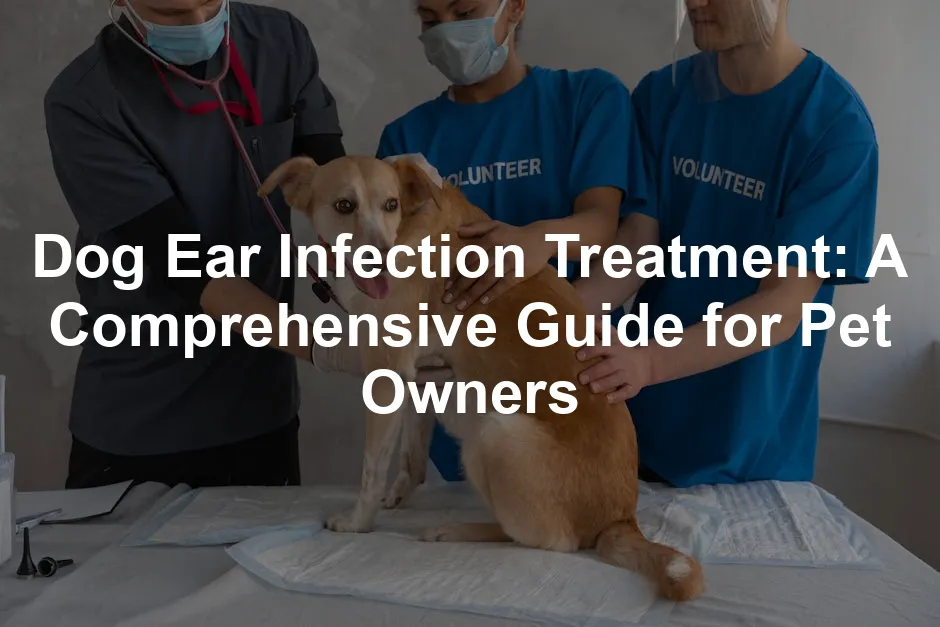Introduction
Ear infections are quite common in dogs. In fact, around 20% of dogs experience some form of ear disease. They can cause discomfort and lead to serious complications if not treated promptly. Early detection is key. Recognizing symptoms early can help prevent more severe issues down the line. This article focuses on effective treatment methods and strategies to prevent ear infections in your furry friends.
To keep those floppy ears clean and healthy, consider using Vet’s Best Ear Relief Dog Cleanser. This gentle solution not only cleans but soothes your pup’s ears, making it a must-have for any dog owner!

Summary and Overview
Approximately 20% of dogs suffer from ear infections. Some breeds, like Basset Hounds and Cocker Spaniels, are especially prone to these issues. Ear infections can be classified into three types: otitis externa (outer ear), otitis media (middle ear), and otitis interna (inner ear). Understanding the symptoms is crucial for early intervention. Common signs include scratching, head shaking, and foul odor from the ears. By being vigilant, you can help ensure your dog remains healthy and comfortable.
For those stubborn infections, you might want to check out Zymox Otic Enzymatic Ear Solution. It’s like a superhero for your dog’s ears, tackling those pesky infections head-on with its powerful enzymes!

Understanding Dog Ear Infections
What is an Ear Infection in Dogs?
Ear infections, or otitis, occur when the ear canal becomes inflamed. They can be categorized into three primary types: otitis externa, otitis media, and otitis interna. The ear anatomy of dogs, particularly their L-shaped ear canal, makes them more susceptible to infections.
In otitis externa, the infection affects the outer ear canal, which is the most common type. Otitis media involves the middle ear and can develop as a complication of external infections. Otitis interna impacts the inner ear, potentially leading to serious complications like hearing loss.
Certain breeds are at higher risk for ear infections, especially those with floppy ears. Basset Hounds, Cocker Spaniels, and Beagles often experience these issues. It’s estimated that around 20% of all dogs will face some form of ear infection during their lives.
Keeping a close eye on your dog’s ear health is essential. If you notice any signs of infection, don’t hesitate to consult your veterinarian. Early action can prevent further complications and keep your dog happy and healthy.
In addition to vet visits, having the right cleaning supplies is crucial. Consider investing in Pet MD Dog Ear Cleaner Wipes. They’re perfect for quick clean-ups and help maintain your dog’s ear hygiene effortlessly!

Symptoms of Dog Ear Infections
Recognizing the Signs
Dog ear infections can be tricky to spot. However, there are key symptoms to watch for. Common signs include excessive scratching, head shaking, ear odor, and discharge. If your dog is constantly pawing at their ears, it may indicate discomfort.
The symptoms can vary depending on the infection type. For example, otitis externa (outer ear infection) often presents with redness and swelling. In contrast, otitis interna (inner ear infection) may cause hearing loss or balance issues.
Did you know that about 50% of dog owners fail to recognize these symptoms until the infection worsens? Keeping a close eye on your dog’s behavior can help catch infections early.
If you notice any unusual ear discharge or strong ear odor, take it seriously. Keeping a symptom diary can be very helpful for tracking any changes. This information can be vital when visiting your vet.
For those who want to be extra prepared, a handy Dog Ear Infection Home Remedy Book can equip you with knowledge on how to manage and prevent these pesky infections!

Causes of Ear Infections
Factors Leading to Infections
Several factors contribute to ear infections in dogs. Bacteria and yeast are common culprits. Allergies also play a significant role, affecting nearly 50% of dogs with allergic skin disease. Moisture retention from swimming or bathing can create a breeding ground for these pathogens.
Environmental factors, like humidity and excessive grooming, can exacerbate the problem. For instance, over-cleaning can irritate the ear canal and promote infections.
Ear mites, though less common, can also lead to infections. It’s essential to be aware of your dog’s grooming habits and environment. Discussing allergy testing with your vet can help identify potential triggers.
By understanding these factors, you can take preventive steps to keep your dog’s ears healthy. Regular check-ups and good grooming practices can make a significant difference.
Speaking of grooming, don’t forget to check out Pawsitively Posh Pet Grooming Gloves. They make grooming a breeze while keeping your dog’s coat healthy and shiny!

Diagnosis of Ear Infections
How Veterinarians Diagnose Ear Infections
Diagnosing ear infections in dogs requires a thorough examination. Your veterinarian will start with a physical examination of your dog’s ears. They’ll check for redness, swelling, and discharge. An otoscopic exam follows, using an otoscope to look deep into the ear canal. This tool helps visualize any abnormalities and assess the health of the eardrum.
Cytology is another essential part of the diagnosis. This involves taking samples from the ear canal. These samples are then examined under a microscope to identify the presence of bacteria or yeast. Common tests include culture and sensitivity testing, which determine the specific pathogens and appropriate treatments.
Did you know that about 30% of ear infections are misdiagnosed? This highlights the importance of a complete veterinary visit. Early and accurate diagnosis can lead to effective treatment and prevent complications. If you notice symptoms like scratching or foul odor, consult your vet promptly. Don’t wait for the issue to worsen—early intervention is key to your dog’s health and comfort.
To help ensure your dog is always ready for their vet visits, consider investing in a Dog Car Seat Cover. It keeps your car clean while providing comfort during trips to the vet!

Treatment Options for Dog Ear Infections
Immediate Care Steps
When your dog has an ear infection, immediate care is crucial. Start by cleaning the ears gently with a vet-approved ear cleaner. This helps remove debris and excess wax. It’s essential to follow your vet’s instructions on how often to clean your dog’s ears.
Topical medications are commonly prescribed. These often include antibiotics and antifungal treatments to combat infections. Your vet may also recommend anti-inflammatory medications to ease discomfort. Following the prescribed treatment plan is vital. Incomplete treatment can lead to recurring infections, which can become harder to manage over time.
Statistics show that recovery rates improve significantly with prompt treatment. Most uncomplicated cases resolve within one to two weeks. However, chronic infections may require more intensive care. This can include a combination of oral antibiotics and topical treatments. Always monitor your dog’s response to treatment and report any concerns to your veterinarian.
If you suspect your dog has an ear infection, don’t hesitate. Schedule a vet appointment as soon as possible. Your furry friend deserves to feel comfortable and healthy.
To make ear cleaning a breeze, consider using TropiClean Ear Cleaner for Dogs. This gentle formula is designed to soothe and clean, making it a fantastic option for ear maintenance!

Long-Term Management
Managing chronic ear infections in dogs requires ongoing care. Regular check-ups with your veterinarian are essential for monitoring your dog’s ear health. These visits can help catch any recurring infections early. Studies show that approximately 50% of dogs with chronic ear infections experience a recurrence without proper management.
Identifying underlying causes is critical. Allergies and endocrine issues, like hypothyroidism, often contribute to persistent infections. If your dog has allergies, work with your vet to develop a tailored treatment plan. This may include allergy testing to pinpoint specific triggers.
Home care maintenance is equally important. Regularly clean your dog’s ears using a veterinarian-approved solution to remove wax and debris. This simple step can significantly reduce the risk of future infections. Consistency in ear cleaning, along with appropriate medical care, can keep your furry friend comfortable and healthy.
For breeds more susceptible to ear infections, such as Basset Hounds and Cocker Spaniels, regular vet check-ups are crucial. Staying proactive in your dog’s ear care can prevent complications and ensure a better quality of life.
Also, consider getting a PetFusion Ultimate Dog Bed to provide your dog with a comfortable space to rest and recover while managing their ear health!
Home Remedies and Preventive Care
Maintaining Ear Health at Home
Keeping your dog’s ears clean is vital for preventing infections. Use a veterinarian-recommended ear cleaning solution, and clean your dog’s ears weekly. Avoid using cotton swabs, as they can push debris further into the ear canal. Instead, use absorbent gauze to gently wipe the outer ear.
Lifestyle changes can also help maintain ear health. After swimming or bathing, ensure your dog’s ears are thoroughly dried. Moisture retention is a common cause of ear infections, so keeping ears dry is essential.
Statistics indicate that dogs with regular ear cleaning are less likely to develop infections. By adopting a routine ear cleaning schedule, you can significantly reduce your dog’s risk. Incorporate this into your pet care routine to promote better hygiene and overall ear health.
Consider setting reminders to check and clean your dog’s ears regularly. This small effort can lead to a happier, healthier pup, free from the discomfort of ear infections.
And while you’re at it, grab some Earth Rated Dog Poop Bags. Keeping your environment clean is just as important as keeping your pup’s ears healthy!

When to See a Vet
Signs Indicating Veterinary Care is Needed
Recognizing when your dog needs urgent veterinary care is crucial. If your dog shows severe symptoms, such as intense pain, swelling, or a strong odor from the ears, don’t wait. These signs can indicate a serious ear infection requiring prompt attention.
Other red flags include discharge that appears yellow or bloody. Additionally, if your dog has difficulty standing or shows signs of balance issues, seek emergency care immediately.
Statistics reveal that untreated ear infections can lead to complications like hearing loss and facial paralysis. Timely veterinary intervention can prevent these severe outcomes. Remember, don’t delay a vet visit if you notice these serious symptoms. Your dog’s health and comfort depend on it.
And while you’re preparing for that vet visit, consider getting a Dog Travel Water Bottle. Keeping your pup hydrated on the go is essential for their overall health!

Conclusion
Proactive care is vital for preventing and treating dog ear infections. By being vigilant and recognizing signs early, you can help your furry friend avoid painful complications. Regularly consult your veterinarian to stay informed about your dog’s ear health.
Key treatment strategies include proper cleaning, medication, and monitoring for recurrent infections. Staying proactive ensures your dog remains comfortable and healthy. Prioritize your pet’s ear care to enhance their quality of life.
Oh, and don’t forget to reward your pup with some tasty treats! Check out the Greenies Original Dental Dog Treats to keep those pearly whites in check while giving them a delicious snack!
Please let us know what you think about our content by leaving a comment down below!
Thank you for reading till here 🙂
All images from Pexels





